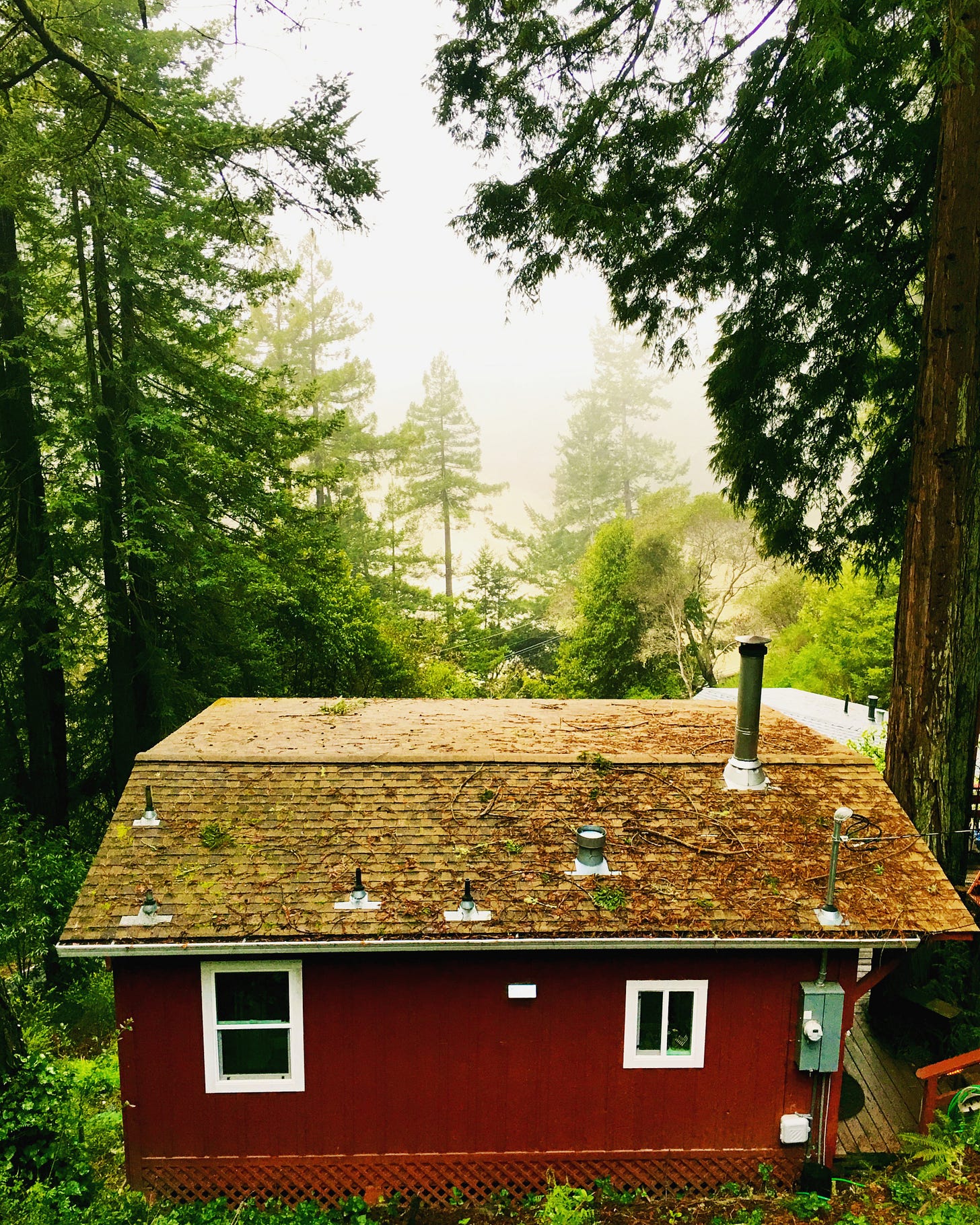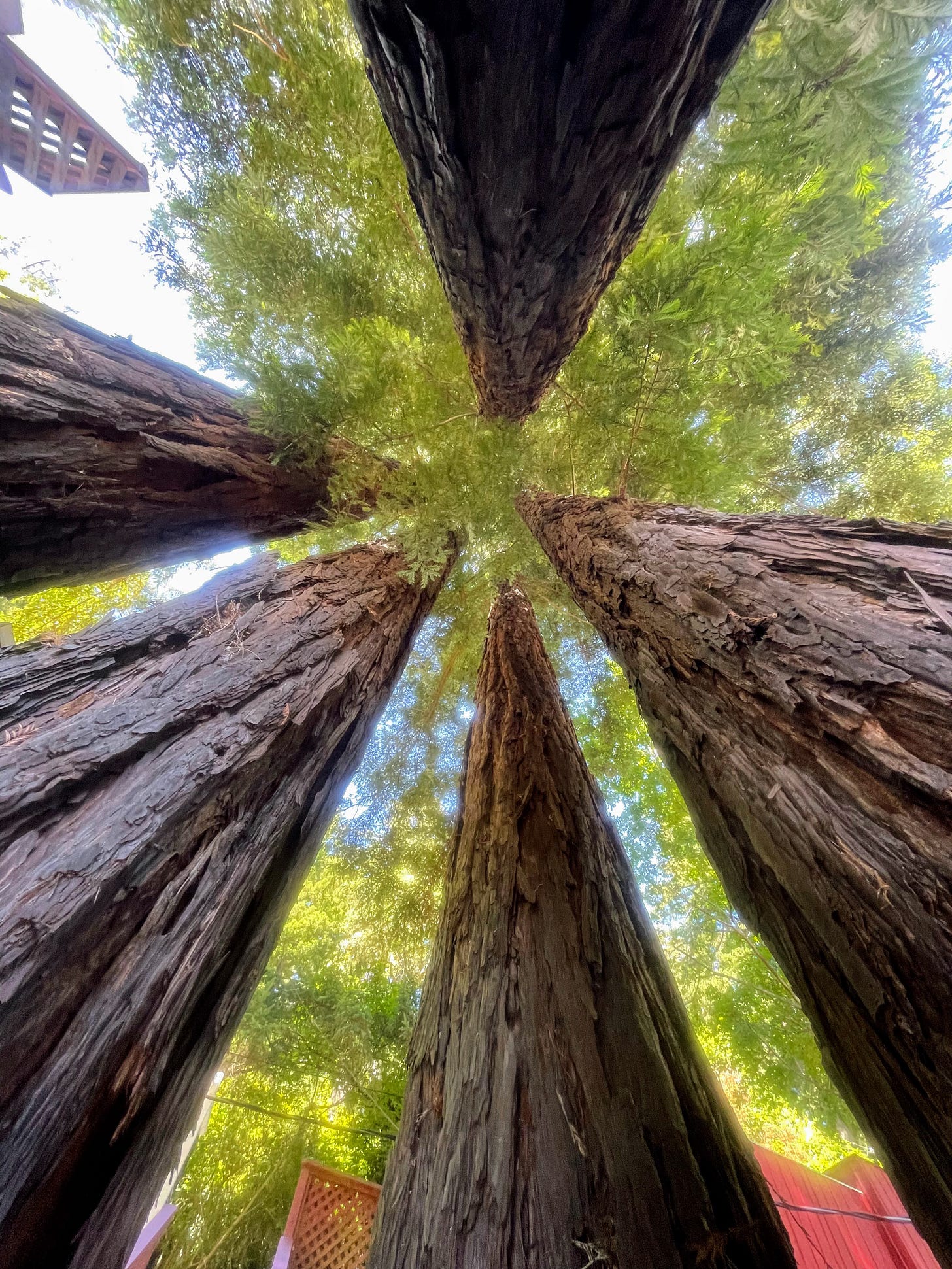Author’s note: though it appears I’m wrapping up our road trip, FEAR NOT! THE BEST of this story IS STILL AHEAD!!! Hang in there with me, and don’t forget to hit the ❤️ to let me know you’re still reading. MAHALO!!!
WHAT IS HOME?
We were able to make it to our place on the river by evening of the next day in a long and a multi-stage process. This involved hauling out from Big Lagoon, a meandering drive along the 101 coastal highway, arriving at the storage lot near Santa Rosa. There we dumped the Retro’s tanks, parked the rig in the spot we’d left months before, unloaded, emptied the fridge, and turned off all the electrical.
Weary in body and soul, we headed toward the Russian River with a mountain of dirty laundry, boxes of administrative stuff, full suitcases, dog accoutrements, and bags of perishable food filling the back seat and rear cargo area.
Our quest for an environmentally safe place to relocate to was officially completed—but not.
We still didn’t know where we were going next. We’d set our sights on the Oregon Coast, but had no luck in finding anything.
This wasn’t the outcome I’d hoped for. I’d wanted to know where ‘home’ would be for us by the end of this trip.
As we drove through vineyards whose orderly rows were aflame with fall color, headed toward the cabin that we’d left in spring and now returned to in late autumn, I was relieved that the constant change of life on the road was about to end.
I was also unsettled. An echo sounded from an empty place inside—one that had always been looking for home.
And as we pulled up the steep, rugged one-lane road leading to the spot where our cabin clung to the redwoods like the Osprey Nest we’d named it for, I had deeper questions: Where is my “home?” What is “home,” anyway?
For close to ten thousand miles and half of the circumference of the United States, I’d been trying to find an answer to that.
As a child who grew up with food and housing instability, bouncing from tent to rental to shack to van, never in one place for more than a year or two, my adult life had been one long attempt to heal that insecurity. Mike went along with this, but reluctantly. He didn’t have the same need to own, to possess—to control. To be padded from ever needing anything acutely again.
Our adult children teased me about my collections of books, art, jewelry, land, and homes, calling me a “dragon” after the great Smaug in The Hobbit. I laughed too but had to admit that my wounded inner child found comfort in the accumulation of valuable possessions.
I put a lot into whatever house I currently called home. Much effort was spent on fluffing that nest, tilling that soil, claiming that space.
And yet I kept getting itchy feet and wanting something different, the challenge of reinvention, the adventure of the new and novel. Mike and I shared this trait; it continued to bind us together.
Eventually, I was satiated in my compulsion to own. By the time we began our quest, I’d begun to be annoyed by the upkeep and hassles of all I’d collected. The taxes. The money worries. The constant weight and responsibility. I wanted to be free—but I still longed for home without really knowing what that was.
I first came across the problem of needing an ongoing sense of “home” while traveling in the first two National Parks road trips we took, documented in Open Road.
During both of those extended trips, I experienced debilitating, free-floating anxiety after too many transitions using tents and motel rooms as lodging.
I’d hoped we could cure this strange sensation by trailer camping on this longer road trip, and to a degree, that worked.
Now at the end of our trip and reflecting on it, I did feel more grounded, for lack of a better term, by having the trailer: a predictable place in which to retreat to rest, rejuvenate, eat, use a familiar bathroom, sit on my special blue beanbag. All the tiny, ordinary, but unique and universal things that make a certain place called “home.”
Through the experience of trailer camping I embraced being a minimalist. I fully experienced how little “stuff” was actually needed to function, feel good, and enjoy life. I took real pleasure in paring my possessions to the bare essentials: my 18” by 24” in. wardrobe, neat and narrow, was visually and otherwise pleasing. I owned only three pairs of shoes, each good quality and highly functional.
To have nothing but what I used or enjoyed each day felt good.
Early in our marriage, as a result of our shared wanderlust, Mike and I embarked on lengthy intercontinental moves as a family: from one end of Hawaii to the other end of the Midwest, and back again. We had one lengthy stop in the middle of our lives, twenty years at one address on Maui when our young children asked us to stay put so they could finish school in one place.
For their sake, we put down roots and let them flourish on that island for the remainder of their school years. During that time, I particularly reconnected to the Hawaiian Islands, the place where I’d grown up, in a deep way.
I called Hawaii, and Maui in particular, home. I knew what that meant, then.
Home was a place with an emotional resonance that matched mine. People, culture, nature, community, church—all these aspects were familiar and beloved, including the house I lived in. Together, they made for a secure sense of belonging.
Eventually the children we’d stayed on the island for grew up and left, as young people usually do from a place with high cost of living and not much to offer in the way of careers.
And so did we. Mike wanted to move to California to help his aging parents and brought me over with the promise of the travel trailer and “one last big adventure.” We landed and perched on the edge of the Russian River in our little red Osprey Nest.
I blinked, and five years passed.
I named the five redwoods that grew up through the deck of the cabin the Ents. All five were “shoots” that had grown from the stump of the mighty One Tree that was first logged a hundred years before. That stump was a hole in the center of the “fairy ring” from which new trunks sprang. Together the Five were mighty.
I loved sheltering under their swishing branches. The trees felt like guardians standing over our cabin with their huge branches extended. “Widowmakers” those branches were called—but I never felt anything but blessings from them.
Summers, I walked the forest roads and swam in the jade green water; winters I watched the surf beat on the silver shore and the river rise and overflow its banks. Springs, we watched the ospreys nest in a tree nearby.
The rest of the time I hoped for rain and worried about fire.
In five years on the Russian River, we were evacuated for serious fire threat six times and for flood, twice.
Our move had been driven by love and obligation for Mike’s mom, and the River was a place where our love of nature could be satisfied—but it wasn’t a safe place.
Even so, we would have stayed if not for the escalating changes around us: the rising prices of the Bay Area, a pandemic that made a tiny place smaller, and the position of our perch: exposed to the wind of fire and the brown mud of rising water, literally held up by redwoods, clinging to the side of a tinderbox hill.
I loved the Osprey Nest cabin and its sheltering trees above the unpredictable river.
But I craved safety more: I wanted the security of living somewhere high above flood, out of reach of tsunami, away from the fault of an earthquake, west of tornadoes, north of hurricanes, and out of fire-prone drought.
This mythical “safe” place would have enough room for Mike to do his woodworking and projects. It would be a house with a view of nature, out of snow in the winter, and affordable for a writer and a social worker to retire in.
Such a dream couldn’t be that hard to find, could it?
Reaching the Osprey Nest after our long camping trip, Mike and I fell into bed with sighs of relief.
I continued to reflect and distill what I’d learned on the trip and got going on my next mystery novel; I hadn’t written any new fiction while traveling, so my business was in dire need of attention.
Meanwhile, fall rolled on without a drop of rain. California baked in drought. I watched the dry redwood needles fall and the Russian River barely trickle past. I worried about fire, and I kept circling back to the deeper questions the trip hadn’t answered: What was “home?” Would I ever know where I belonged? Why did I continue longing for Hawaii?
Yet we chose not to return because of the expense and distance from our kids, who’d recently married. Now grandchildren were on the way. I couldn’t bear to miss out on their first smiles, first steps, first little red rain boots.
My heart was in two places: Hawaii, and the continent. Would we ever find a “forever home” that met all of our needs?
Was “home” a place, or a house, or a state of mind?
Every time I felt the discomfort of my unsettled questions, I experienced a peaceful reassurance from the divine source I’d known all my life, the One that sheltered me like the trees did. All my needs would be met. The answers would be evident at the right time.






Where one belongs is a question that has bothered me for half a century. Grew up in Sweden, went to graduate school in Berkeley, got a job in Seattle, married, got three kids who have now all left the nest. Several times I have been close to taking a job in Sweden. Really do not know where I belong.
Having lived in 8 houses (grew up in one and the other 7 were with hubby and kids and grandkids) in my 72 years (Illinois, New Jersey and Belgium), I always told my husband, I won’t worry about where we’re going till the moving truck shows up. Unlike your situation we were never in fear of floods or fire, so these moves were relatively easy. Had plans to retire in NC but then grandkids came along and blew that thought out of our minds. NJ is our home, two of our three kids and our four grandkids live within 30 minutes of us and we visit our youngest in Florida when we can. Our roots are here, our sisters and brothers from other moms and dads are here. We are blessed. I hope you and Mike find that.